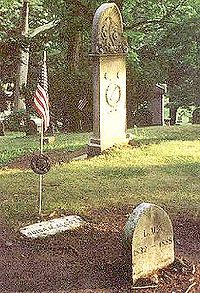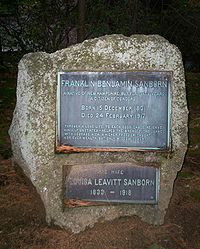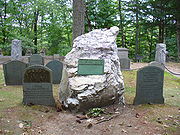
Sleepy Hollow Cemetery, Concord
Encyclopedia


Cemetery
A cemetery is a place in which dead bodies and cremated remains are buried. The term "cemetery" implies that the land is specifically designated as a burying ground. Cemeteries in the Western world are where the final ceremonies of death are observed...
located on Bedford Street near the center of Concord, Massachusetts
Concord, Massachusetts
Concord is a town in Middlesex County, Massachusetts, in the United States. As of the 2010 census, the town population was 17,668. Although a small town, Concord is noted for its leading roles in American history and literature.-History:...
. The cemetery is the burial site of a number of famous Concordians, including some of the United States
United States
The United States of America is a federal constitutional republic comprising fifty states and a federal district...
' greatest authors and thinkers, especially on a hill known as "Author's Ridge."
History
Sleepy Hollow was designed in 1855 by noted landscape architects Cleveland and CopelandCleveland and Copeland
Cleveland and Copeland were a noted American landscape architecture firm.The firm was organized by Horace William Shaler Cleveland and Robert Morris Copeland...
, and has been in use ever since. It was dedicated on September 29, 1855; Ralph Waldo Emerson
Ralph Waldo Emerson
Ralph Waldo Emerson was an American essayist, lecturer, and poet, who led the Transcendentalist movement of the mid-19th century...
gave a dedication speech and would be buried there decades later. Both designers of the cemetery had decades-long friendships with many leaders of the Transcendentalism
Transcendentalism
Transcendentalism is a philosophical movement that developed in the 1830s and 1840s in the New England region of the United States as a protest against the general state of culture and society, and in particular, the state of intellectualism at Harvard University and the doctrine of the Unitarian...
movement, and their design reflects that.
"Sleepy Hollow was an early natural garden designed in keeping with Emerson's aesthetic principles," writes Joachim Wolschke-Bulmahn in his Nature and Ideology. In 1855, landscape designer Robert Morris Copeland delivered an address he entitled The Usefull [sic] and The Beautiful, tying his principles of naturalistic, organic garden design to Emerson's Transcendentalist principles. Shortly, afterward, Copeland and his partner were retained by the Concord Cemetery Committee, of which Emerson was an active member, to design a cemetery for the growing community.
On September 29, 1855, Emerson delivered the opening address of the cemetery's consecration. In it he lauded the designers' work. "The garden of the living," said Emerson, was as much for the benefit for the living, to communicate their relationship to the natural world, as it was to honor the dead. By situating the monuments to the dead within a natural landscape
Natural landscape
A natural landscape is a landscape that is unaffected by human activity. A natural landscape is intact when all living and nonliving elements are free to move and change. The nonliving elements distinguish a natural landscape from a wilderness. A wilderness includes areas within which natural...
, the architects conveyed their message, said Emerson. A cemetery could not "jealously guard a few atoms under immense marbles, selfishly and impossibly sequestering [them] from the vast circulations of nature [which] recompenses for new life [each decomposing] particle."
Known as Sleepy Hollow for some 20 years prior to its use as a cemetery, the newly-consecrated landscape would, Emerson told his audience that September day in Concord, "When these acorns, that are falling at our feet, are oaks overshadowing our children in a remote century, this mute green bank will be full of history: the good, the wise, and the great will have left their names and virtues on the trees... will have made the air tuneable and articulate."
To realize their vision, Emerson noted that the cemetery's designers had fitted the walks and drives into the site's natural amphitheater. They also left much of the original natural vegetation in place, instead of removing it and replanting with ornamental shrubs, as was often the case. Several years after Emerson's address, a visitor to the new cemetery noted the abundance of wild plants such as woodbine, raspberry, and goldenrod, as well as the natural moss and roots of pine trees which were left in situ
In situ
In situ is a Latin phrase which translated literally as 'In position'. It is used in many different contexts.-Aerospace:In the aerospace industry, equipment on board aircraft must be tested in situ, or in place, to confirm everything functions properly as a system. Individually, each piece may...
by the designers.
The Melvin Memorial, also known as Mourning Victory, sculpted by Daniel Chester French
Daniel Chester French
Daniel Chester French was an American sculptor. His best-known work is the sculpture of a seated Abraham Lincoln at the Lincoln Memorial in Washington, D.C.-Life and career:...
marks the grave of three brothers killed in the Civil War.
People are still being buried there. The back of the newer portion of the cemetery leads to a path system which connects to the Great Meadows National Wildlife Refuge
Great Meadows National Wildlife Refuge
The Great Meadows Wildlife Refuge, is a twelve-mile long river wetlands conservation area, in two major parcels, stretching from the towns of Billerica, Massachusetts to Wayland, Massachusetts , along the Concord and Sudbury rivers...
.
Notable burials

- The Alcott family, including Amos Bronson AlcottAmos Bronson AlcottAmos Bronson Alcott was an American teacher, writer, philosopher, and reformer. As an educator, Alcott pioneered new ways of interacting with young students, focusing on a conversational style, and avoided traditional punishment. He hoped to perfect the human spirit and, to that end, advocated a...
(Transcendentalist, philosopher, educator), Abby MayAbby MayAbigail "Abby" Alcott was the wife of Transcendentalist Amos Bronson Alcott and mother of four daughters, including Civil War novelist Louisa May Alcott...
(Wife of Amos Bronson Alcott), and their daughter Louisa May AlcottLouisa May AlcottLouisa May Alcott was an American novelist. She is best known for the novel Little Women and its sequels Little Men and Jo's Boys. Little Women was set in the Alcott family home, Orchard House in Concord, Massachusetts, and published in 1868...
(author of Little WomenLittle WomenLittle Women is a novel by American author Louisa May Alcott . The book was written and set in the Alcott family home, Orchard House, in Concord, Massachusetts. It was published in two volumes in 1868 and 1869...
and others) - Ephraim Wales BullEphraim Wales BullEphraim Wales Bull was the creator of the Concord grape.-Biography:Born in Boston, Massachusetts, Bull was apprenticed to a gold-beater at a young age. On September 10, 1826, he married Mary Ellen Walker of Dorchester, Massachusetts. Complaining of lung problems, he moved away from the city...
(inventor of the Concord Grape) - William Ellery Channing (TranscendentalistTranscendentalismTranscendentalism is a philosophical movement that developed in the 1830s and 1840s in the New England region of the United States as a protest against the general state of culture and society, and in particular, the state of intellectualism at Harvard University and the doctrine of the Unitarian...
and poet) - Ralph Waldo EmersonRalph Waldo EmersonRalph Waldo Emerson was an American essayist, lecturer, and poet, who led the Transcendentalist movement of the mid-19th century...
(TranscendentalistTranscendentalismTranscendentalism is a philosophical movement that developed in the 1830s and 1840s in the New England region of the United States as a protest against the general state of culture and society, and in particular, the state of intellectualism at Harvard University and the doctrine of the Unitarian...
and poet) - Daniel Chester FrenchDaniel Chester FrenchDaniel Chester French was an American sculptor. His best-known work is the sculpture of a seated Abraham Lincoln at the Lincoln Memorial in Washington, D.C.-Life and career:...
(sculptor of the Lincoln MemorialLincoln MemorialThe Lincoln Memorial is an American memorial built to honor the 16th President of the United States, Abraham Lincoln. It is located on the National Mall in Washington, D.C. The architect was Henry Bacon, the sculptor of the main statue was Daniel Chester French, and the painter of the interior...
) - Nathaniel HawthorneNathaniel HawthorneNathaniel Hawthorne was an American novelist and short story writer.Nathaniel Hawthorne was born in 1804 in the city of Salem, Massachusetts to Nathaniel Hathorne and the former Elizabeth Clarke Manning. His ancestors include John Hathorne, a judge during the Salem Witch Trials...
(author of The Scarlet LetterThe Scarlet LetterThe Scarlet Letter is an 1850 romantic work of fiction in a historical setting, written by Nathaniel Hawthorne. It is considered to be his magnum opus. Set in 17th-century Puritan Boston during the years 1642 to 1649, it tells the story of Hester Prynne, who conceives a daughter through an...
and others) - Sophia Hawthorne (wife of Nathaniel Hawthorne)
- George Frisbie HoarGeorge Frisbie HoarGeorge Frisbie Hoar was a prominent United States politician and United States Senator from Massachusetts. Hoar was born in Concord, Massachusetts...
(19th-century politician) - Richard MariusRichard MariusRichard Curry Marius was an American academic and writer.He was a scholar of the Reformation, novelist of the American South, speechwriter, and teacher of writing and English literature at Harvard University...
(ReformationProtestant ReformationThe Protestant Reformation was a 16th-century split within Western Christianity initiated by Martin Luther, John Calvin and other early Protestants. The efforts of the self-described "reformers", who objected to the doctrines, rituals and ecclesiastical structure of the Roman Catholic Church, led...
historian and Southern novelist) - Ralph MunroeRalph MunroeRalph Middleton Munroe was an American yacht designer and early resident of Coconut Grove in south Florida. His home, now The Barnacle Historic State Park, is the oldest house in Miami-Dade County still standing in its original location.-Early life:Munroe was born to Thomas and Ellen Middleton...
(yacht designer and pioneer of South FloridaFloridaFlorida is a state in the southeastern United States, located on the nation's Atlantic and Gulf coasts. It is bordered to the west by the Gulf of Mexico, to the north by Alabama and Georgia and to the east by the Atlantic Ocean. With a population of 18,801,310 as measured by the 2010 census, it...
) - Elizabeth PeabodyElizabeth PeabodyElizabeth Palmer Peabody was an American educator who opened the first English-language kindergarten in the United States. Long before most educators, Peabody embraced the premise that children's play has intrinsic developmental and educational value.-Biography:Peabody was born in Billerica,...
(education reformer) - Franklin Benjamin SanbornFranklin Benjamin SanbornFranklin Benjamin Sanborn was an American journalist, author, and reformer. Sanborn was a social scientist, and a memorialist of American transcendentalism who wrote early biographies of many of the movement's key figures...
(author and social reformer) - Henry David ThoreauHenry David ThoreauHenry David Thoreau was an American author, poet, philosopher, abolitionist, naturalist, tax resister, development critic, surveyor, historian, and leading transcendentalist...
(TranscendentalistTranscendentalismTranscendentalism is a philosophical movement that developed in the 1830s and 1840s in the New England region of the United States as a protest against the general state of culture and society, and in particular, the state of intellectualism at Harvard University and the doctrine of the Unitarian...
, philosopher, and author) - George Washington WrightGeorge Washington WrightGeorge Washington Wright was a Californian politician. He was the leading vote getter in a November 1849 at-large election for California's first two Representatives in the 31st United States Congress serving from September 11, 1850, to March 3, 1851.-External links:...
(California's first representative in Congress)

